Jasper Lake Fanless Showdown: ECS LIVA Z3 and ZOTAC ZBOX CI331 nano UCFF PCs Review
by Ganesh T S on July 8, 2022 8:30 AM EST- Posted in
- Systems
- ZOTAC
- Fanless
- ECS
- Passive Cooling
- UCFF
- Mini-PC
- Jasper Lake
HTPC Credentials
The HTPC-related sections in previous SFF PC reviews covered a range of aspects. Display refresh rate stability (particularly, the ability to drive 23.976 Hz for stutter-free playback of cinema content), OTT streaming efficiency (YouTube and Netflix), and local media playback performance and efficiency evaluation were some of them. While such a detailed study may still make sense for dedicated HTPC reviews, we have decided to pare down the evaluated aspects for system reviews. Workloads were processed on the ECS JSLM-MINI and the ZOTAC ZBOX CI331 nano for the results in this section.
YouTube Streaming Efficiency
4K video streaming has become ubiquitous enough for its support to be a necessity even for secondary HTPCs. HDR has also become affordable. Keeping these aspects in mind, we have chosen Mystery Box's Peru 8K HDR 60FPS video as our test sample moving forward. On PCs running Windows, it is recommended that HDR streaming videos be viewed using the Microsoft Edge browser after putting the desktop in HDR mode.

YouTube Streaming - ECS JSLM-MINI

YouTube Streaming - ZOTAC ZBOX CI331 nano
Intel's UHD Graphics for Gen 11 supports hardware decoding for VP9 Profile 2. Taking advantage of this feature, MS Edge automatically fetches the 4Kp60 VP9 Profile 2 encode from the YouTube servers. However, the playback was punctuated by frequent dropped frames on both systems as shown in the statistics segment of the above screenshots.
Various metrics of interest such as GPU usage and at-wall power consumption were recorded for the first four minutes of the playback of the above video. The numbers are graphed below.
The reason for the dropped frames is evident by the spikes in D3D Usage. However, as we shall see further down in this section, this problem doesn't manifest itself in local playback. The culprit here seems to be the MS Edge browser itself, rather than the hardware platform.
Hardware-Accelerated Encoding and Decoding
The transcoding benchmarks in the systems performance section presented results from evaluating the QuickSync encoder within Handbrake's framework. The iGPU in the systems support hardware encode for AVC, JPEG, HEVC (8b and 10b, 4:2:0 and 4:4:4), and VP9 (8b and 10b, 4:2:0 and 4:4:4). The capabilities of the decoder engine are brought out by DXVAChecker. They were the same for both the ECS JSLM-MINI and the ZOTAC ZBOX CI331 nano.
The decoder engine in Jasper Lake is not the latest and greatest that Intel has to offer. For example, HEVC and VP9 12b support, as well as AV1 support are absent. AV1 is quite new, and the others are required only for professional applications - market segments that are not targeted by Jasper Lake systems.
Local Media Playback
Evaluation of local media playback and video processing is done by playing back files encompassing a range of relevant codecs, containers, resolutions, and frame rates. A note of the efficiency is also made by tracking GPU usage and power consumption of the system at the wall. Users have their own preference for the playback software / decoder / renderer, and our aim is to have numbers representative of commonly encountered scenarios. Considering the target market for Jasper Lake systems, we played back the test streams using the following install-and-forget combinations:
- VLC 3.17.4
- Kodi 19.4
The fourteen test streams (each of 90s duration) were played back from the local disk with an interval of 30 seconds in-between. Various metrics including GPU usage and at-wall power consumption were recorded during the course of this playback. Based on the DXVAChecker report presented previously, the GPU should be able to play back all codecs with hardware acceleration (except for AV1).
All our playback tests were done with the desktop HDR setting turned on. It is possible for certain system configurations to automatically turn on/off the HDR capabilities prior to the playback of a HDR video, but, we didn't take advantage of that in our testing.
VLC and Kodi
VLC is the playback software of choice for the average PC user who doesn't need a ten-foot UI. Its install-and-play simplicity has made it extremely popular. Over the years, the software has gained the ability to take advantage of various hardware acceleration options. Kodi, on the other hand, has a ten-foot UI making it the perfect open-source software for dedicated HTPCs. Support for add-ons make it very extensible and capable of customization. We played back our test files using the default VLC and Kodi configurations, and recorded the following metrics.
| ECS JSLM-MINI Video Playback Efficiency - VLC and Kodi | |||
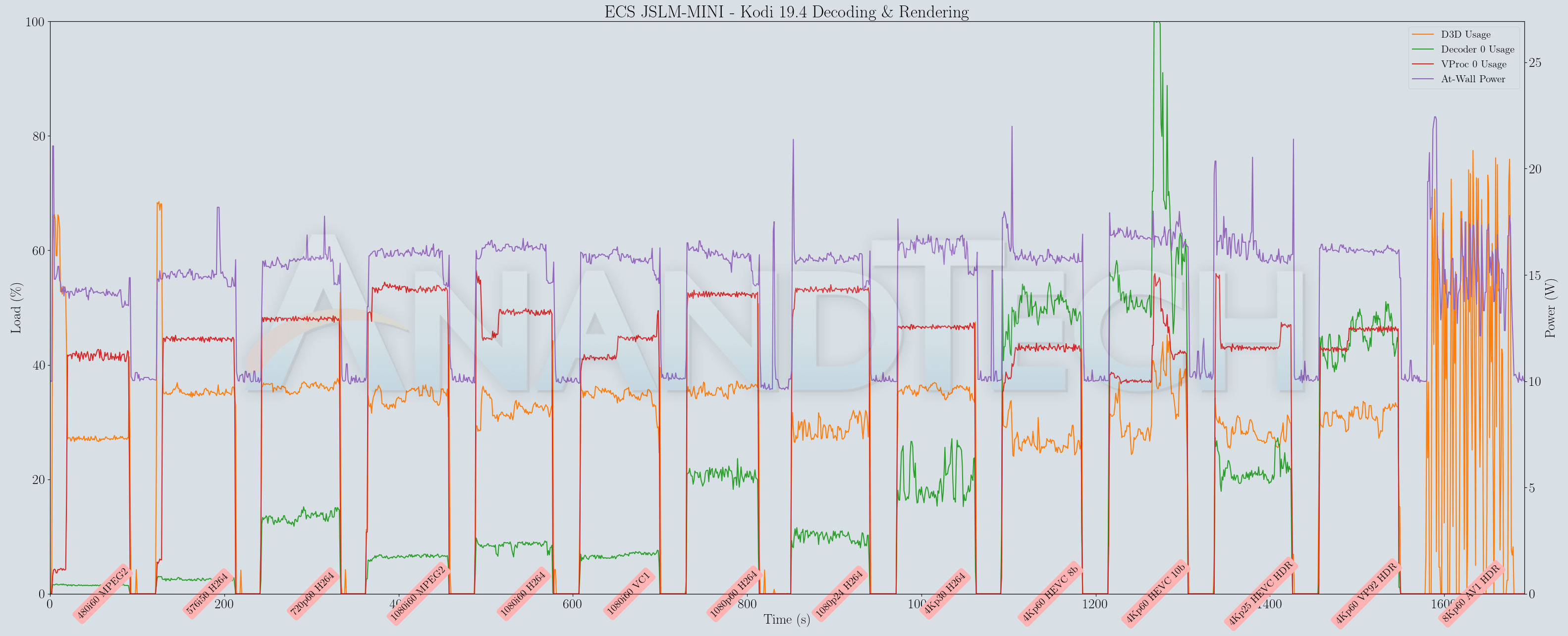
| ZOTAC ZBOX CI331 nano Video Playback Efficiency - VLC and Kodi | |||
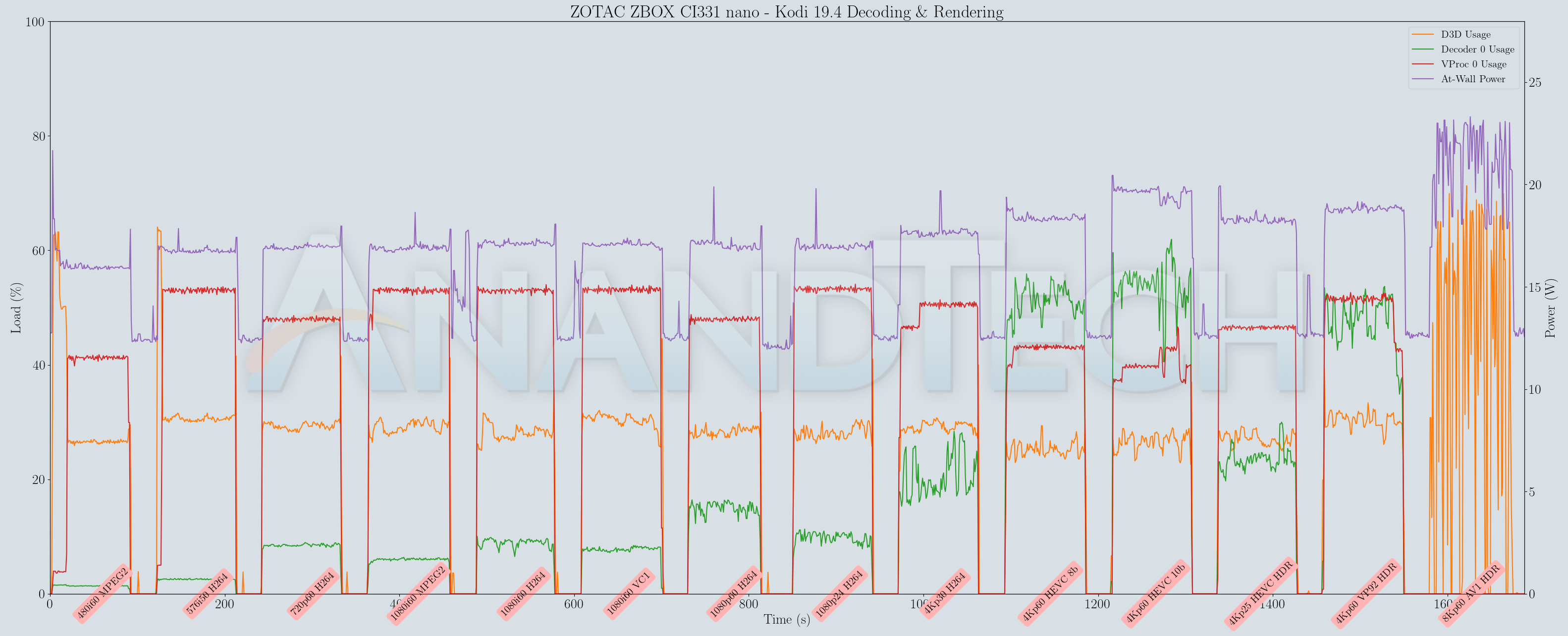
Both players in both systems had great trouble handling the 8Kp60 AV1 clip, due to the absence of hardware acceleration. In addition to consuming lots of power, the playback was just a sequence of frames updated every few seconds. Other than that, all other codecs played without missing a frame, with hardware acceleration activated for low-power playback.
Overall, both systems can be recommended for media playback from the local disk or over the local network. Using web browsers is a hit or miss depending on the codec, resolution, and browser. The presence of hardware acceleration also ensures that the systems are unlikely to get thermally limited during playback.


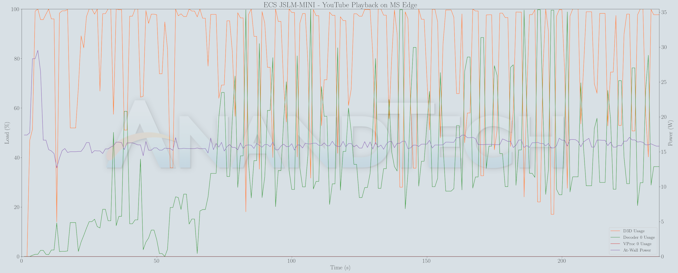
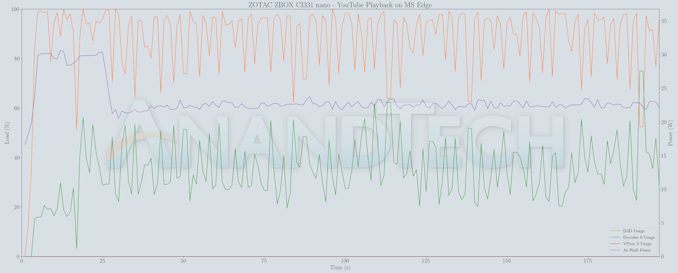
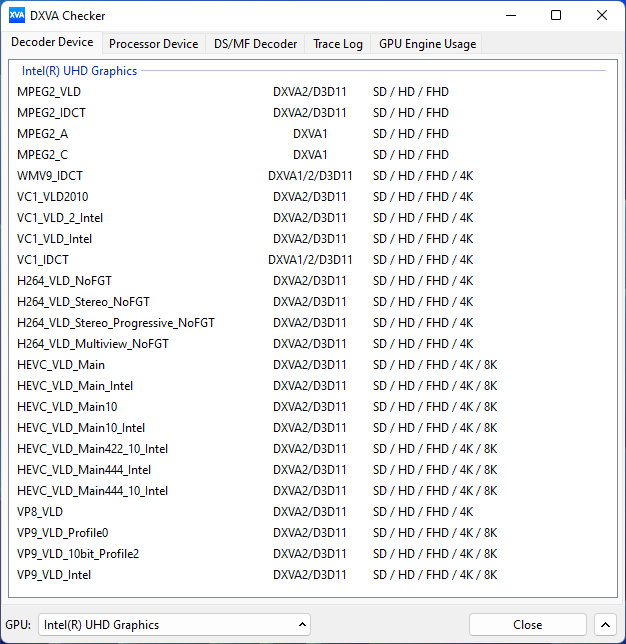








52 Comments
View All Comments
mode_13h - Saturday, July 9, 2022 - link
> tldr both benches would have been a wash one way of the other.Huh? If old Skylake is 50% faster, and Jasper Lake is 3.5x as fast as Pi 4 Model B (which seems rather generous), then it wouldn't be "a wash", which is defined as:
13. an action or situation in which the gains and losses are
equal, or closely compensate each other.
(source: http://dict.org/bin/Dict?Form=Dict2&Database=g... )
or
8: any enterprise in which losses and gains cancel out; "at the
end of the year the accounting department showed that it was
a wash"
(source: http://dict.org/bin/Dict?Form=Dict2&Database=w... )
Since both comparisons are projected to be substantially lopsided, I think what you meant to call it is a "washout"?
abufrejoval - Thursday, July 14, 2022 - link
I have a PI4 with 8GB of RAM in a metal case that supports a 2GHz overclock without active cooling: pretty much the best PI you can have these days.I also have an Nvidia Tegra based Jetson Nano with 4GB of RAM.
At 2GHz the PI reaches 272/648 on Geekbench 4, the Tegra has to make do with 206/718 at 1.4GHz. The N6005 Jasper Lake reaches 781/2540 very similar to a Sandy Bridge i7-2600 at 3.8GHz Turbo.
The Jetson Nano actually does reasonably well on my 43" 4k desktop for basic 2D work, because it has a GPU with 128 Maxwell cores. Of course its CPU power is at the level of a Snapdragon 800 mobile phone.
The PI struggles badly at 4k, because the GPU has much less muscle. The slightly faster CPU is hard to notice.
Actually it was when Tom's hardware did a report on a PI compute cluster, that I wanted to retort just how stupid that project was, because you could get a single Jasper Lake Atoms for much less money, that would run rings around that cluster and could in fact simulate it all in software via VMs.
And that's when I found that finally a Jasper Lake NUC was available for purchase at €200 (including VAT) and immediately ordered one of the first and last ever sold here.
And yes, it runs rings around both with roughly 4x the CPU power, 64GB of RAM expandability and quite a reasonable GPU performance on a 4k display.
My favorite usability test is to use the "3D Globe View" on Google Maps under a Chrome based browser on Windows and to then tilt and turn a city landscape there. It's about the most efficient 3D graphics pipeline I've ever seen (puts Flight Simulator to total shame!) and performs quite reasonable on such a Jasper Lake NUC. With Firefox it's much worse on these low power devices, but with a beefy PC you'd never notice.
After quite a bit of tweaking I managed to get it to work on both the PI and the Tegra at 1920x1080 and the Tegra even gave a bit of interactivity thanks to its much stronger GPU. But on the PI that was about one frame a minute.
The PI and Nano are toys and ok for the €100 I spent on each.
A Jasper Lake NUC is quite a reasonable desktop machine and even an interesting micro server for some real workloads.
At €200 (without RAM or storage) the price/performance ratio is very hard to beat, but evidently none of the vendors really want you to know or buy that. I think it's the major reason you never could.
mode_13h - Thursday, July 14, 2022 - link
> At 2GHz the PI reaches 272/648 on Geekbench 4, the Tegra ... 206/718 at 1.4GHz.Keep in mind that Jetson Nano has ostensibly 2x the memory bandwidth of the Pi v4. That surely helps offset the difference in raw CPU performance, as well as with 4k display performance.
Oh, and if that test was with the machines driving a 4k display, then merely refreshing your monitor will have been using a non-insignificant amount of the Pi's memory bandwidth (about 1 GB/s).
> N6005 Jasper Lake reaches 781/2540
Wow! Dual-channel memory configuration, I presume?
> on the PI that was about one frame a minute.
Uh... that sure sounds like you were using a software rendering path. The Pi's GPU is trash, but that's simply atrocious!
> evidently none of the vendors really want you to know or buy that.
> I think it's the major reason you never could.
I'm reasonably confident it's actually just supply chain-related. Intel has been steering its limited fab capacity towards more profitable models and probably steering its limited supply of Jasper Lakes to chromebooks, where they're probably desperate not to lose market share.
timecop1818 - Friday, July 8, 2022 - link
There are Chinese mini PCs withIntel Celeron N5100 that are like 250$ with 16G ram and 256gb sata SSD.
https://www.lazada.com.my/products/walkfish-m6-11t...
there's like 5 different "brands" selling same thing on AliExpress etc. it runs win 10 just fine and is enough for 1080p Minecraft and basic office computing. great deal. most models have Intel 2.5G Ethernet too.
Jorgp2 - Friday, July 8, 2022 - link
I just want a Jasper lake motherboard with plenty of sata and a PCI-E slotmode_13h - Friday, July 8, 2022 - link
You could get SATA, but not PCIe. According to this, Jasper Lake and Elkhart Lake have only x8 PCIe 3.0 and x2 SATA ports.Most boards are probably going to give you a x4 NVMe slot. Then, they could use a 3rd Party SATA controller to give you 4 more ports. Then, if they compromise on the bandwidth to that SATA controller, you can have a second Ethernet port and then a x1 PCIe slot that just might be open-ended (but probably not), to support a graphics card.
Sorry, but they really kneecapped this platform relative to what it could've been. You might do better with some equivalent Atom-branded CPUs. Atom C-series (Parker Ridge) has 16 integrated SATA ports, x32 PCIe 3.0 lanes, and up to 8 cores. P-series (Snow Ridge) has the same, but up to 24 cores.
* https://ark.intel.com/content/www/us/en/ark/produc...
* https://ark.intel.com/content/www/us/en/ark/produc...
mode_13h - Friday, July 8, 2022 - link
Oops, forgot the link for Jasper Lake. For good measure, here's Elkhart Lake, as well.* https://ark.intel.com/content/www/us/en/ark/produc...
* https://ark.intel.com/content/www/us/en/ark/produc...
Thala - Friday, July 8, 2022 - link
Interestingly my 3 years old Surface Pro X scores higher than any of the tested devices in Cinebench R23 under x64 emulation!mode_13h - Saturday, July 9, 2022 - link
The Surface Pro X from 2019 has a Microsoft SQ1 SoC, which is basically a Snapdragon 8cx and consists of 4x Kryo 495 Gold @ 3 GHz+ 4x Kryo 495 Silver @ 1.80 GHz (manufactured on TSMC 7 nm). According to wikichip, these are tweaked A76 and A55 cores. So, that seems credible, if not exactly an outcome I'd have presumed.Something to keep in mind is that Jasper Lake is meant cheap chromebooks. Like, sub-$200 cheap, whereas Snapdragon 8cx is a premium part.
nandnandnand - Saturday, July 9, 2022 - link
They wanted it to be thought of as premium, it's more of an expensive joke. Like Lakefield but with no excuses.https://semiaccurate.com/2021/12/01/qualcomm-8cx-g...
https://www.gizchina.com/2022/01/04/qualcomm-blame...
Snapdragon 7c (Gen 1?) should be more comparable in price to Jasper Lake. I think I've seen that as low as $170-200. Also, the Apcsilmic Dot 1 and ECS LIVA Mini Box QC710 mini PCs recently launched with the 7c starting at around $219.
If the leaks about Alder Lake-N are true, it will shake things up, if the price is right.